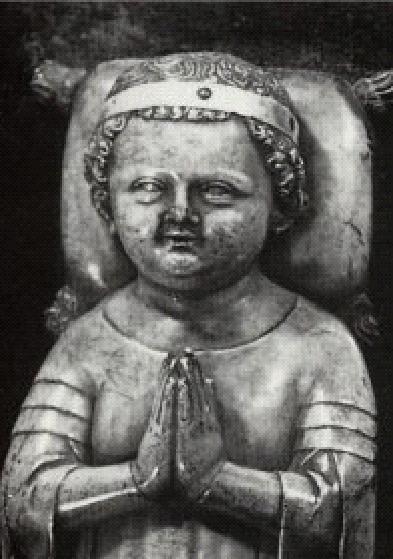- John I of France
Infobox French Royalty|monarch
name=John I the Posthumous
title=King of France and Navarre
Count of Champagne
caption=Tomb Effigy of John the Posthumous
reign=15 November –20 November 1316
coronation=
full name=
predecessor=Louis X
successor=Philip V
royal house=House of Capet
royal anthem =
father=Louis X
mother=Clémence d'Anjou
date of birth=birth date|1316|11|15|df=y
place of birth=Paris ,France
date of death=death date and age|1316|11|20|1316|11|15|df=y
place of death=Paris ,France
place of burial=Saint Denis Basilica |John I (
15 November 1316 –20 November 1316 ), called the Posthumous, was King of France and Navarre, and Count of Champagne, as the son and successor of Louis X, for the five days he lived. He thus had the shortest official reign of any French king.He was born a king of the
House of Capet and the posthumous son of Louis X andClémence d'Anjou .John lived for only a few days and many believed his uncle, the future King Philip V, caused his death in order to gain the throne. There were also stories that Philip had the child kidnapped and substituted a dead child in his place. During the 1350s, a man claiming to be King John I appeared in
Provence . He was quickly put in prison and died there.John reigned for five days under his uncle's regency, until his death on
November 20 ,1316 . The infant King was buried inSaint Denis Basilica . He was succeeded by his uncle, Philip V. The other claimant was John's half-sister, the then four-year-old Princess Joan (Jeanne in French), daughter of Louis X's marriage with Marguerite of Burgundy.It was at this point that the question of the force of
Salic Law was resolved regarding the succession to the Throne of France.Joan, as a female, had a disputed claim to the throne of France: a female could not succeed to the throne of France if following the
Salic law ; however, if following the feudal law (which had thus far controlled the inheritance of almost all fiefs in France), Joan would have been the next monarch of France. (She did, however, have undeniable rights in the succession of Navarre where females are allowed - witness that kingdom being brought to the Capetians by Louis' own mother. However, these claims were ignored until after the deaths of her uncles Philip V and Charles IV.)A practical point obviously having impact on this legal interpretation was the rumour that Joan was a product of her mother's adultery and not at all a daughter of Louis X. By interpreting the law as allowing only male succession Joan's position was quashed altogether, and the danger of a bastard succeeding was avoided without even examining her real birth.
These events form part of the narrative of
Les Rois Maudits (The Accursed Kings), a series of historical novels byMaurice Druon .Ancestors
ee also
*
List of shortest reigning monarchs of all time References
Bibliography:
Tommaso di Carpegna Falconieri, "L'uomo che si credeva re di Francia. Una storia medievale", Roma-Bari 2005, ISBN 88-420-7619-8
Tommaso di Carpegna Falconieri, "The Man Who Believed He was King of France", transl. by William McCuaig, University of Chicago Press 2008, ISBN 9780226145259
